Photographing Iron Pagoda Park: Capture the Essence of Chinese Heritage
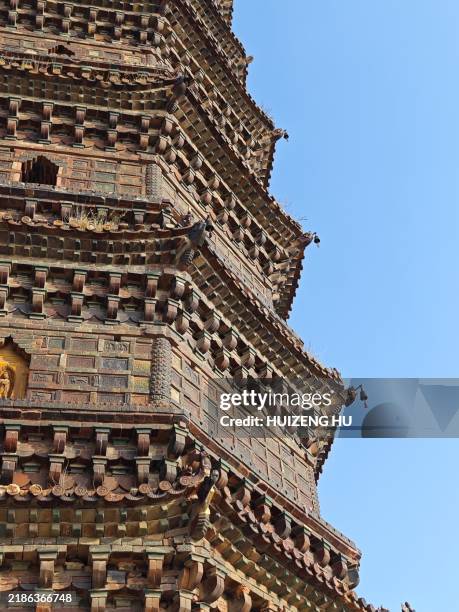
An Essential Guide to Visiting Iron Pagoda Park
In This Guide
- An Essential Guide to Visiting Iron Pagoda Park
- The Rich History and Legends of Iron Pagoda Park
- Main Highlights: What You Absolutely Can’t Miss
- Planning Your Visit: A Practical Guide
- Tickets: Prices, Booking, and Tips
- How to Get There: A Complete Transportation Guide
- Local Cuisine and Accommodation Nearby
- Frequently Asked Questions
- Final Thoughts on Your Trip
Nestled in the heart of Kaifeng, the historic capital of the Northern Song Dynasty, Iron Pagoda Park (铁塔公园) stands as a tribute to China’s architectural prowess and cultural heritage. This enchanting destination is not merely a park; it is a living museum that encapsulates nearly a millennium of history and craftsmanship. Here, visitors can marvel at the iconic Iron Pagoda, an exquisite example of glazed brick architecture that has withstood the ravages of time, war, and nature.
A Journey Through Time
Constructed in 1049 under the auspices of the Song emperor, the Iron Pagoda was originally designed to house the relics of Sakyamuni, the founder of Buddhism. Its impressive 13-story structure reaches a height of 55.63 meters and is adorned with a stunning palette of reddish-brown glazed bricks that shimmer in the sunlight. The pagoda’s silhouette, resembling iron from a distance, gives it its name and has earned it the title of “the first pagoda under heaven.”
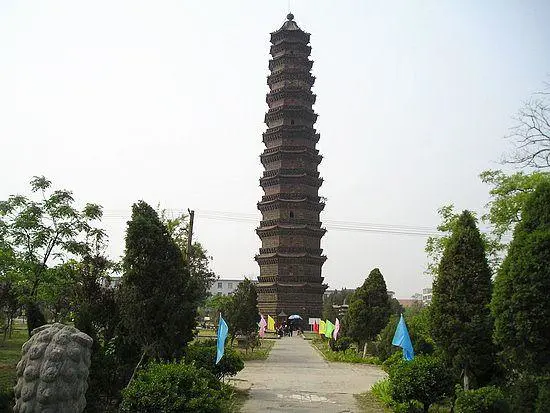
Iron Pagoda Park.
What Awaits You
As you step into Iron Pagoda Park, you will be greeted by a blend of tranquility and historical significance. The park, sprawling with lush gardens and ancient trees, invites you to wander and explore. Key highlights of your visit include:
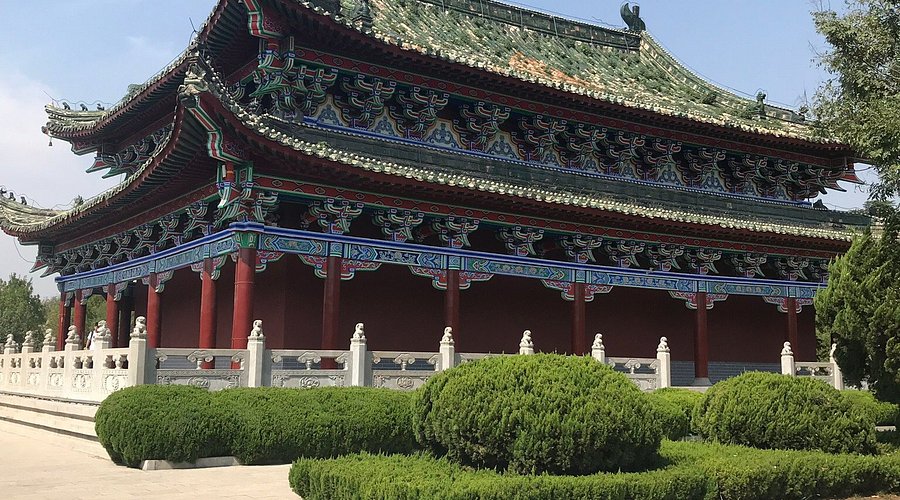
Iron Pagoda Park.
- Iron Pagoda Tower: The crown jewel of the park, this remarkable structure invites you to ascend its 168 steps for breathtaking panoramic views of Kaifeng and the winding Yellow River.
- Jieyin Hall: Located at the foot of the pagoda, this hall houses a revered White Jade Buddha statue, a gift from overseas Chinese residing in Myanmar, which adds to the spiritual ambiance of the site.
- Bonsai Garden: A serene space showcasing the artistry of bonsai cultivation, this garden features a variety of meticulously arranged plants, reminiscent of traditional Chinese landscaping.
- Cultural Events: Depending on the time of your visit, you may be fortunate enough to witness the dazzling Iron Pagoda Light Show or the annual Chrysanthemum Flower Festival, where vibrant blooms transform the park into a kaleidoscope of colors.
Planning Your Visit
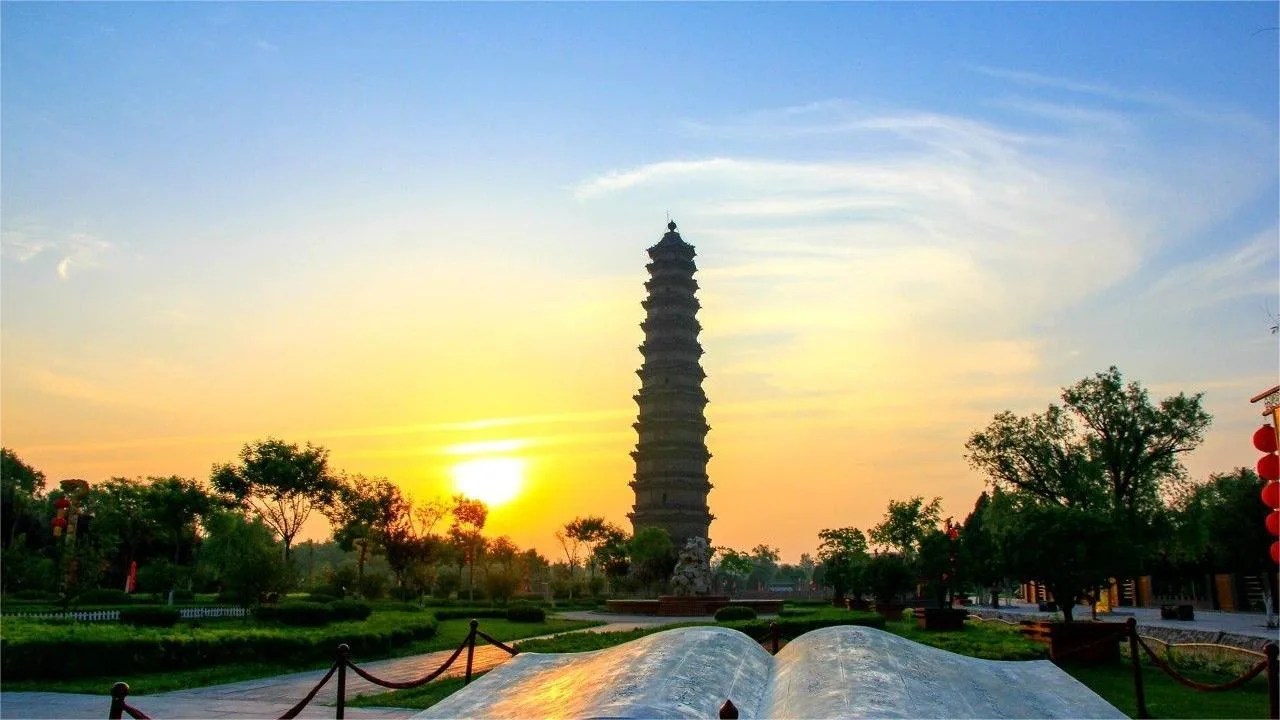
Iron Pagoda Park.
To fully experience the allure of Iron Pagoda Park, aim to visit during spring (March to May) or autumn (September to November) when the weather is pleasantly mild. The park is easily accessible via local bus routes, making it a convenient stop during your exploration of Kaifeng.
Whether you are an architecture enthusiast, a history buff, or simply seeking a peaceful retreat, Iron Pagoda Park offers an immersive experience that connects you with the rich tapestry of Chinese culture and history. Prepare to be captivated by its beauty and significance as you embark on this unforgettable journey.

Iron Pagoda Park.
The Rich History and Legends of Iron Pagoda Park
Nestled in the heart of Kaifeng, Iron Pagoda Park (铁塔公园) serves as a remarkable testament to China’s rich architectural heritage and historical significance. The park is home to the iconic Iron Pagoda, an exquisite example of Song dynasty craftsmanship, which has captured the imagination of visitors for centuries.
Historical Significance
The Iron Pagoda, originally known as the Kaibao Temple Pagoda, was constructed in 1049 AD during the Northern Song dynasty. Commissioned by the Song emperor, this 13-story octagonal structure stands tall at 55.63 meters and is made from intricately glazed bricks, which give it a striking reddish-brown hue. This color, reminiscent of iron, led to its enduring nickname. Despite its name, the pagoda is not made of iron; rather, its design and materials symbolize the strength and resilience that characterize this historical period.
The pagoda was built to house the relics of Sakyamuni, the founder of Buddhism, effectively intertwining religious significance with architectural brilliance. As the tallest, largest, and oldest glazed brick pagoda in China, it has withstood the test of time, enduring wars, floods, and earthquakes while remaining a beacon of cultural pride for the region.
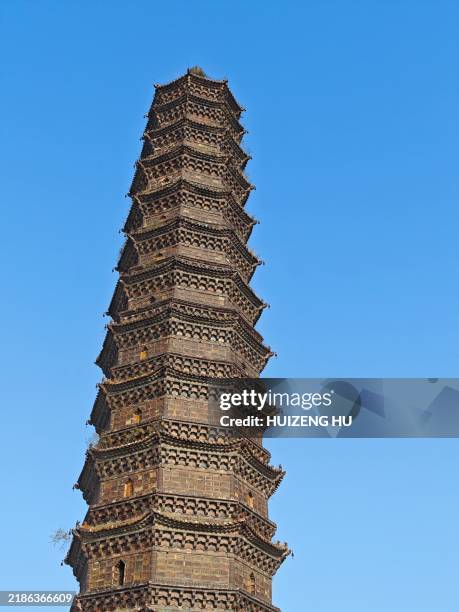
Iron Pagoda Park.
Architectural Marvel
The pagoda’s architectural prowess is evident in its 168 brick steps that spiral around a central column, leading visitors to breathtaking views of the surrounding landscape, including the meandering Yellow River. This unique structure not only serves as an awe-inspiring sight but also offers a glimpse into the advanced building techniques of the Song dynasty, celebrated as one of China’s most prosperous eras.
Cultural Legends
As with many ancient structures, the Iron Pagoda is shrouded in legends that enhance its allure:
-
The Guardian Spirit: Local folklore suggests that a guardian spirit protects the pagoda. It is said that this spirit appears during storms to shield the pagoda from lightning strikes, which historically caused the destruction of its wooden predecessor in 1044 AD.
-
The Eight Scenes of Kaifeng: The pagoda is listed as one of the Eight Scenes of Kaifeng, a collection of picturesque sites that highlight the city’s beauty. The view from the top, where visitors can see the clouds enveloping the pagoda, is particularly celebrated and draws travelers eager to experience this natural phenomenon.
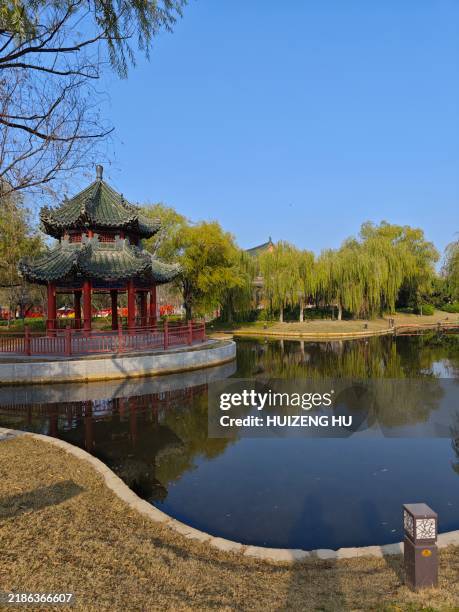
Iron Pagoda Park.
Cultural Events and Attractions
Visitors to Iron Pagoda Park can also enjoy its surrounding features, including:
-
Jieyin Hall: Located directly in front of the pagoda, this hall enshrines a White Jade Buddha Statue of Sakyamuni, donated by overseas Chinese in 1933. The statue, crafted from a single piece of jade, adds to the spiritual atmosphere of the park.
-
Bonsai Garden: Opened in 1994, this garden showcases the largest collection of bonsai in Henan Province, presenting a serene environment with traditional Chinese landscaping elements such as water features and bridges.
-
Seasonal Festivals: The park hosts various events, including the annual Chrysanthemum Flower Festival from mid-October to mid-November, where vibrant blooms transform the landscape into a colorful spectacle. The Iron Pagoda also hosts a stunning Light Show, utilizing advanced technology to create an unforgettable visual experience.
Conclusion
Iron Pagoda Park represents more than just a beautiful location; it is a living museum of Chinese history and culture. Whether you are captivated by its architectural grandeur, intrigued by its legends, or simply seeking a peaceful escape, a visit to this historic site promises an enriching experience that resonates with the spirit of ancient China.
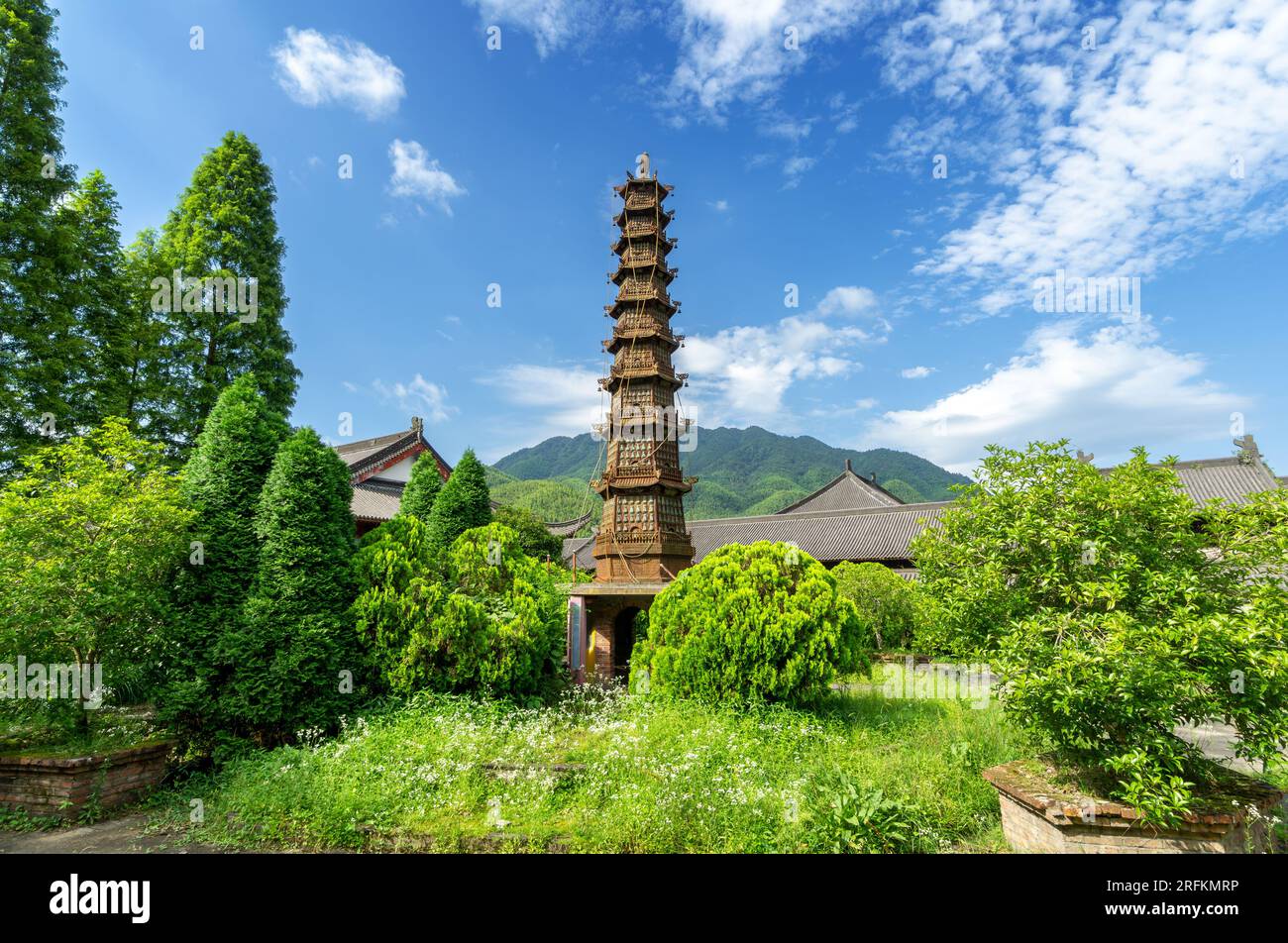
Iron Pagoda Park.
Main Highlights: What You Absolutely Can’t Miss
Discovering the Treasures of Iron Pagoda Park
Nestled in the heart of Kaifeng, Iron Pagoda Park (铁塔公园) is a gem that encapsulates centuries of Chinese history and architectural brilliance. As one of Kaifeng’s most renowned attractions, it offers international travelers a unique window into the cultural heritage of the Song Dynasty and beyond. Here are the main highlights that you absolutely cannot miss when visiting this historic park.
1. The Majestic Iron Pagoda
At the center of the park stands the iconic Iron Pagoda (铁塔), originally known as the Kaibao Temple Pagoda. Built in 1049 during the Northern Song Dynasty, this 13-story octagonal structure towers at 55.63 meters high. Crafted from reddish-brown glazed bricks, its silhouette resembles iron, lending it its name. Recognized as the tallest and best-preserved glazed brick pagoda in China, it has withstood the test of time, surviving wars, floods, and earthquakes.
- Climb to New Heights: Visitors can ascend the 168 brick steps that spiral around a central column to the top of the pagoda. The panoramic views from the summit offer breathtaking sights of the Yellow River and the sprawling city of Kaifeng, making it a perfect photo opportunity.
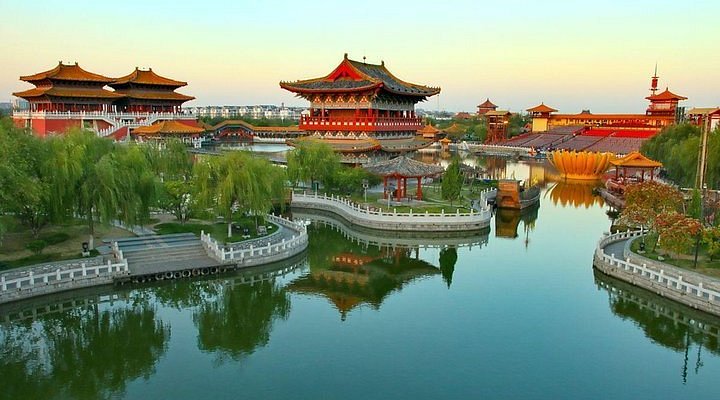
Iron Pagoda Park.
2. Jieyin Hall
Directly in front of the Iron Pagoda lies Jieyin Hall, a serene space dedicated to the worship of a stunning White Jade Buddha statue of Sakyamuni. Donated by an overseas Chinese in 1933, this exquisite statue stands about one meter tall and adds a spiritual aura to the park. The hall itself is a tranquil spot for reflection and admiration of Buddhist artistry.
3. The Bonsai Garden
For a taste of traditional Chinese horticulture, don’t miss the Bonsai Garden. Established in 1994, it is the largest specialized bonsai plantation in Henan Province. The garden features a diverse array of bonsai varieties, beautifully arranged amid picturesque landscapes that include water features, bridges, and rockeries. It’s an idyllic setting for leisurely strolls and appreciating the artistry of nature.
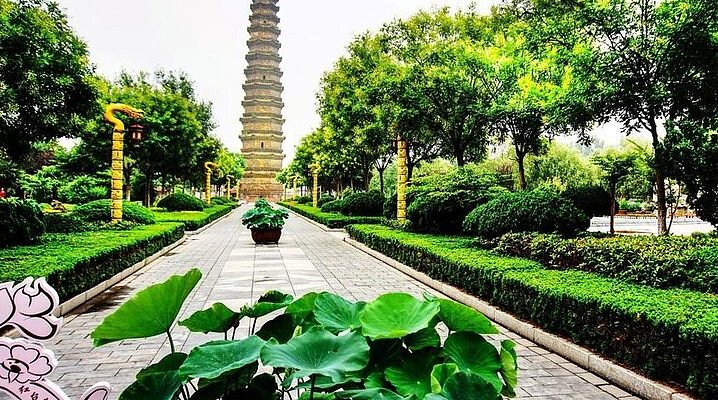
Iron Pagoda Park.
4. The Iron Pagoda Light Show
As dusk falls, the park transforms into a vibrant spectacle with the Iron Pagoda Light Show. This stunning nighttime display combines advanced technologies such as 4D imaging, holographic projections, and laser effects to illuminate the pagoda and its surroundings. It’s a must-see event that brings the history and beauty of the site to life in an unforgettable way.
5. The Chrysanthemum Flower Festival
If your visit coincides with the Chrysanthemum Flower Festival, held annually from October 18 to November 18, you are in for a treat. During this time, the park is adorned with vibrant displays of chrysanthemums in various colors. This festival highlights the beauty of nature and offers an excellent opportunity for photography as the city celebrates its floral heritage.
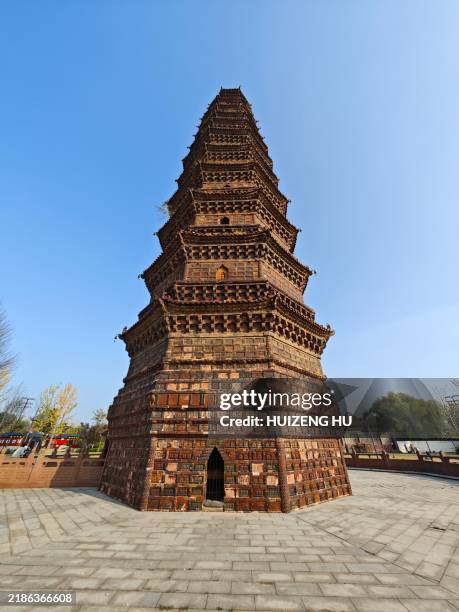
Iron Pagoda Park.
Practical Tips for Your Visit
- Best Time to Visit: The ideal months are March to May and September to November when the weather is mild and pleasant.
- Opening Hours: The park is open daily from 7:00 AM to 7:00 PM, allowing ample time to explore its many attractions.
- Getting There: Conveniently accessible by public transport, take Bus Routes 1, 3, 10, 18, or 20 from Kaifeng Railway Station directly to Iron Pagoda Park.
Final Thoughts
Iron Pagoda Park is more than just a historical site; it’s a vibrant tapestry of culture, architecture, and natural beauty. Whether you’re climbing the pagoda for panoramic views, wandering through the bonsai garden, or enjoying a dazzling light show, the park offers an enriching experience that connects you to China’s rich heritage. Don’t miss this extraordinary destination on your journey through Kaifeng!
Planning Your Visit: A Practical Guide
Your Essential Guide to Visiting Iron Pagoda Park
As you embark on your journey to explore the rich tapestry of Chinese history and culture, a visit to Iron Pagoda Park (铁塔公园) in Kaifeng, Henan Province, is a must. This park is not just a scenic spot; it is home to the iconic Iron Pagoda, a masterpiece of Song dynasty architecture that has withstood the tests of time. Here’s everything you need to know for a fulfilling visit.

Iron Pagoda Park.
Location and Accessibility
Iron Pagoda Park is conveniently located at No. 210 Beimen Street, Kaifeng, Henan Province, China. Getting there is straightforward:
- Public Transportation: Buses number 1, 3, 10, 18, and 20 run frequently from the Kaifeng Railway Station to the park.
- Walking: If you are staying nearby, the park is a pleasant walk away and offers beautiful views along the way.
Park Hours
The park is open daily from 7:00 AM to 7:00 PM. It’s advisable to arrive early to enjoy the tranquility of the park before the crowds gather.

Iron Pagoda Park.
Best Time to Visit
For the most enjoyable experience, plan your visit during March to May or September to November. During these months, the weather is mild and comfortable, making it perfect for exploring the park and its attractions.
Highlights of Iron Pagoda Park
1. The Iron Pagoda
- Historical Significance: Originally built in 1049 during the Song dynasty, this 13-story octagonal pagoda stands at 55.63 meters tall and is famed for its exquisite architectural style. Though it appears to be made of iron from a distance, it is constructed from glazed bricks in various earthy tones.
- Climb to the Top: Visitors can ascend 168 brick steps to the top floor, where panoramic views of the Yellow River and the city of Kaifeng await.
2. Jieyin Hall
- Located directly in front of the Iron Pagoda, Jieyin Hall houses a stunning White Jade Buddha Statue of Sakyamuni, a gift from overseas Chinese in 1933. The hall is a serene spot for contemplation and reflection.
3. Bonsai Garden
- Established in 1994, this garden is the largest dedicated bonsai collection in Henan Province. Its picturesque layout includes water features, bridges, and rockeries, making it a delightful escape into nature.
4. Cultural Events
- Iron Pagoda Light Show: A spectacular nighttime event featuring 4D imaging and laser displays that illuminate the pagoda and surrounding park.
- Chrysanthemum Flower Festival: Held annually from October 18 to November 18, this festival showcases stunning displays of chrysanthemums throughout the park.
Tips for Your Visit
- Wear Comfortable Shoes: The park is expansive, and you’ll want to explore its many walking paths, so comfortable footwear is essential.
- Bring a Camera: Don’t forget your camera to capture the stunning architecture and beautiful landscapes.
- Local Cuisine: After exploring, consider trying local Kaifeng dishes at nearby restaurants. Recommendations include traditional noodle dishes and local street food.
Nearby Attractions
While in Kaifeng, extend your exploration to other notable sites:
– Qingming Riverside Landscape Garden
– Xiangguo Monastery
– Dragon Pavilion Park
– Kaifeng City Wall
Conclusion
Iron Pagoda Park is more than just a destination; it’s a gateway into the heart of Chinese history and culture. Whether you are marveling at the architectural grandeur of the Iron Pagoda, strolling through the serene bonsai garden, or enjoying a cultural festival, your visit is sure to be a memorable experience. Plan ahead, immerse yourself in the beauty of the park, and enjoy every moment of your journey through Kaifeng.
Tickets: Prices, Booking, and Tips
When planning your visit to the enchanting Iron Pagoda Park in Kaifeng, it’s essential to have all the necessary details regarding ticket prices, booking options, and handy tips to enhance your experience. Below is a comprehensive guide to ensure your visit is as smooth and enjoyable as possible.
Ticket Information
-
Admission Price: The entrance fee to Iron Pagoda Park is approximately 30 RMB (about $5 USD). This fee grants you access to the entire park, including the Iron Pagoda itself and its surrounding attractions.
-
Discounts: Reduced prices may be available for students, seniors, and children. Always carry an identification card to benefit from these discounts.
Booking Your Tickets
-
On-Site Purchase: Tickets can be purchased directly at the entrance gate of Iron Pagoda Park. However, during peak tourist seasons or special events, lines can become lengthy, so it’s advisable to arrive early.
-
Online Reservations: For those who prefer to plan ahead, online booking through various travel platforms is possible. Websites like TripAdvisor or local travel agencies often provide options for pre-purchasing tickets. This can save time and ensure you don’t miss out on this historical gem.
Opening Hours
- Visiting Hours: Iron Pagoda Park is open from 7:00 AM to 7:00 PM daily. Arriving early allows you to enjoy the tranquil morning atmosphere, capturing the pagoda bathed in the soft glow of dawn.
Tips for Your Visit
-
Best Time to Go: The optimal months for visiting are from March to May and September to November. During these times, the weather is mild and the park is adorned with beautiful blooms, making for picturesque views.
-
Guided Tours: Consider joining a guided tour for a more enriching experience. Knowledgeable guides can provide insights into the historical significance of the pagoda and the surrounding park, enhancing your understanding of this cultural landmark.
-
Exploration Essentials: Wear comfortable shoes as you may want to explore the park’s beautiful landscape, including the bonsai garden and various pavilions. Bring water, especially during warmer months, and don’t forget your camera to capture the stunning architecture and scenery.
-
Evening Light Shows: If your schedule allows, stay for the Iron Pagoda Light Show, which features impressive multimedia displays. Check local listings for the show timings, especially if you visit during the chrysanthemum flower festival, which typically occurs from October 18 to November 18.
Getting There
- Transportation: The park is accessible by various bus routes (3, 10, 18, 20, and 1) from the Kaifeng Railway Station. Taxis and ride-sharing services are also readily available for a more direct route.
By following this guide, you’re well-equipped to make the most of your visit to Iron Pagoda Park, immersing yourself in the rich tapestry of Chinese history and culture that this magnificent site has to offer. Enjoy your journey through time!
How to Get There: A Complete Transportation Guide
Navigating Your Way to Iron Pagoda Park
Iron Pagoda Park, or 铁塔公园 (Tie Ta Gong Yuan), is a magnificent historical site located in the heart of Kaifeng, Henan Province. With its stunning architecture and rich cultural significance, visiting this park is a must for anyone interested in Chinese history. Here’s how to reach this iconic landmark.
Getting to Kaifeng
Before heading directly to Iron Pagoda Park, you’ll need to make your way to Kaifeng. The city is well-connected by various transportation options:
-
By Air: The nearest major airport is Zhengzhou Xinzheng International Airport (CGO), located about 70 kilometers from Kaifeng. From the airport, you can take a train or taxi to Kaifeng.
-
By Train: Kaifeng has a railway station that connects to major cities across China, including Beijing, Shanghai, and Zhengzhou. High-speed trains are available, making it a convenient choice for travelers.
-
By Bus: Long-distance buses operate from various locations in Henan and surrounding provinces, arriving at Kaifeng’s main bus station.
Reaching Iron Pagoda Park
Once you’re in Kaifeng, reaching Iron Pagoda Park is straightforward. Here are your best options:
- Public Transportation:
-
Buses: Several bus routes service Iron Pagoda Park directly from Kaifeng Railway Station. Look for routes 1, 3, 10, 18, and 20. Buses are frequent and affordable, making this an excellent option for budget-conscious travelers.
-
Taxi or Ride-Hailing Services:
- Taxis are readily available throughout Kaifeng, and can be a convenient way to reach the park if you’re traveling with luggage or prefer door-to-door service.
-
Ride-hailing apps like Didi Chuxing can also be used for easy navigation around the city.
-
Walking: If you’re staying nearby, walking to Iron Pagoda Park can be a pleasant option. The park is situated northeast of the city center, and the scenic routes often provide a glimpse of local life and architecture.
Tips for Visitors
-
Opening Hours: Iron Pagoda Park is open daily from 7:00 AM to 7:00 PM, so plan your visit accordingly to make the most of your experience.
-
Best Time to Visit: The ideal times to visit Kaifeng are during the spring (March to May) and autumn (September to November) when the weather is mild and comfortable for exploring.
-
Cultural Events: If your visit coincides with the annual Chrysanthemum Flower Festival (October 18 to November 18), be sure to experience this vibrant celebration that showcases stunning floral displays throughout the city.
By following this transportation guide, you’ll find reaching Iron Pagoda Park to be an accessible and enjoyable part of your trip. Embrace the journey as you explore one of China’s most treasured cultural sites!
Local Cuisine and Accommodation Nearby
Savoring Kaifeng: Culinary Delights and Comfortable Stays
As you explore the historical marvels of Iron Pagoda Park (铁塔公园), you’ll find that the experience is enhanced by indulging in local culinary treasures and enjoying convenient accommodations in the area. Kaifeng, with its rich cultural heritage and vibrant atmosphere, offers a delightful array of flavors and hospitable places to rest.
Local Cuisine to Try
When in Kaifeng, don’t miss the chance to sample some of the region’s iconic dishes:
-
Kaifeng Dumplings (开封水饺): These dumplings are a staple of local cuisine, often filled with pork, vegetables, or seafood. Enjoy them steamed or fried, and pair them with a tangy dipping sauce for a perfect bite.
-
Baked Pancakes (开封灌汤包): A beloved street food, these pancakes are filled with savory meat and spices, then baked to golden perfection. Look for vendors near the park for an authentic taste.
-
Beef Noodles (牛肉面): A hearty bowl of beef noodles is perfect for a filling meal. The tender beef and rich broth make this dish a must-try.
-
Zhengzhou Roast Duck (郑州烤鸭): While famous in other regions of China, this local twist on duck features a unique blend of spices and is often served with a sweet sauce and thin pancakes.
-
Chrysanthemum Tea (菊花茶): Perfectly refreshing, this floral tea is popular in Kaifeng and pairs beautifully with any meal. It’s known for its health benefits and pleasantly mild flavor.
Recommended Dining Spots
-
SuShi Beef Noodle
A local favorite known for its savory beef noodles and warm atmosphere. It’s the ideal spot to experience authentic Kaifeng flavors.
Distance: 1.5 miles from Iron Pagoda Park -
Di Yi Lou (Sihou Street)
This restaurant offers a wide range of traditional dishes, including the famous Kaifeng dumplings. Its cozy ambiance makes it perfect for a meal after a day of sightseeing.
Distance: 1.8 miles from Iron Pagoda Park -
ZhenLu KaoRou
Specializing in grilled dishes, this restaurant is a hotspot for meat lovers. Enjoy a variety of grilled skewers, accompanied by local dipping sauces.
Distance: 1.6 miles from Iron Pagoda Park
Places to Stay
After a day of exploration, unwind in one of Kaifeng’s comfortable accommodations:
-
Kaifeng JinPin Hotel
This hotel offers modern amenities and is conveniently located near the park and other attractions. With friendly staff and comfortable rooms, it’s a great choice for travelers.
Distance: Approximately 1.7 miles from Iron Pagoda Park -
HuAn Coffee
A cozy café that doubles as an informal lodging option, offering a unique experience for travelers looking for a homey atmosphere. Enjoy a cup of coffee or tea while planning your next adventure.
Distance: 1.1 miles from Iron Pagoda Park -
FeiLengCui Theme Restaurant
Not only does this restaurant serve delicious local dishes, but it also offers themed accommodations for a unique stay. Immerse yourself in local culture while enjoying a comfortable night’s rest.
Distance: 2.7 miles from Iron Pagoda Park
Conclusion
Kaifeng’s culinary scene and welcoming accommodations enhance the rich historical experience offered by Iron Pagoda Park. As you enjoy the splendid architecture and serene landscapes, be sure to indulge in the local flavors and rest in comfort, truly making your visit memorable.
Frequently Asked Questions
Frequently Asked Questions about Iron Pagoda Park
1. What is the Iron Pagoda Park known for?
Iron Pagoda Park is renowned for its stunning Iron Pagoda, an architectural masterpiece built during the Song Dynasty. The pagoda, constructed in 1049, is celebrated for its exquisite glazed brick design and stands as a symbol of ancient Chinese architecture. The park also features beautiful gardens, a bonsai garden, and several historical sites, including Jieyin Hall, which houses a remarkable White Jade Buddha statue.
2. What are the opening hours of Iron Pagoda Park?
The park is open daily from 7:00 AM to 7:00 PM. Visitors are encouraged to plan their visit within these hours to fully enjoy the park’s attractions.
3. How can I get to Iron Pagoda Park?
You can reach Iron Pagoda Park conveniently by taking local buses. Bus routes 3, 10, 18, 20, and 1 operate near Kaifeng Railway Station and provide direct access to the park.
4. When is the best time to visit Iron Pagoda Park?
The ideal times to visit are during spring (March to May) and autumn (September to November) when the weather is mild and pleasant. These seasons also enhance the park’s natural beauty, making it perfect for exploration and photography.
5. Are there any special events held at Iron Pagoda Park?
Yes! From October 18 to November 18 each year, the park hosts a Chrysanthemum Flower Festival, showcasing vibrant displays of chrysanthemums in various colors. Additionally, visitors can enjoy the Iron Pagoda Light Show, which utilizes advanced technology for a spectacular visual experience.
6. What should I expect to see inside the Iron Pagoda?
Inside the Iron Pagoda, there are 168 brick steps that spiral up to the top. Visitors can enjoy breathtaking panoramic views of the surrounding city and the Yellow River from the top floor, making it a rewarding climb for those interested in stunning vistas.
7. Is there an entrance fee for Iron Pagoda Park?
Yes, there is an entrance fee to access Iron Pagoda Park, which helps maintain the park’s facilities and preserve its historical sites. The exact amount can vary, so it’s advisable to check the latest information prior to your visit.
8. What other attractions are nearby?
Iron Pagoda Park is centrally located near other significant attractions in Kaifeng, including Xiangguo Temple, Dragon Pavilion Park, and the Millennium City Park. Visitors can easily explore multiple sites in one day, enriching their cultural experience in this historic city.
Final Thoughts on Your Trip
As you prepare to depart from Iron Pagoda Park, take a moment to reflect on the rich tapestry of history and culture that you have just experienced. Standing before the majestic Iron Pagoda, you have not only witnessed an architectural marvel that has withstood the test of time but also engaged with the heart of Kaifeng’s storied past.
A Journey Through Time
The Iron Pagoda, built in the Northern Song Dynasty, is more than just a structure; it is a testament to the artistry and resilience of Chinese architecture. As you climbed its 168 steps, each one resonated with the echoes of history, offering breathtaking views of the Yellow River and the charming city below.
Nature and Culture Intertwined
Strolling through the park, you may have found yourself enchanted by the serene Bonsai Garden, where nature and artistry meld into a harmonious landscape. The park’s layout, punctuated by interesting bridges and vibrant flora, invites you to linger a little longer, immersing yourself in the tranquil ambiance.
Events and Experiences
If you were fortunate enough to visit during the chrysanthemum flower festival, or perhaps caught a glimpse of the dazzling Iron Pagoda Light Show, you have witnessed Kaifeng at its most vibrant. These events not only celebrate the beauty of nature but also embody the spirit of community and tradition that thrives in this ancient city.
Leaving with Memories
As you leave Iron Pagoda Park, carry with you the stories of the past and the beauty of the present. Let the memories of this enchanting place inspire a deeper appreciation for China’s rich cultural heritage. Whether it’s the intricate details of the pagoda or the serenity of the bonsai garden, your journey through Iron Pagoda Park is sure to remain a cherished chapter in your travels.
In the words of the great poet Du Fu, “The journey of a thousand miles begins with a single step.” May your steps continue to lead you to new adventures, filled with the wonders of history and culture. Safe travels!